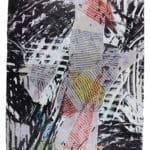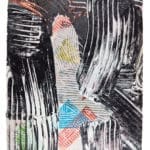The Ruth and Seymour Landfield Atrium
As a pillar of modernist painting, Sam Gilliam has had a profound influence as an innovative contemporary artist. To this day, his work continues to inspire younger generations. Beginning in the 1960s in Washington D.C., the legendary artist pursued the development of a new Abstract Expressionism that celebrated the cultivation of the individual voice that helped to transcend cultural and political boundaries.
Recently acquired into the collection, Sam Gilliam’s 2005 Dogon suite of lithographic, intaglio, and relief prints present a nebula of color and form using rich tones and sinuous lines. Dogon I – V draws its title from the Dogon, a West African culture who possessed a remarkable knowledge of astronomy, centuries ahead of the invention of telescopes and other advanced technologies. While ultimately a unique suite of works, the overlapping rhythm and coloration of Dogon I – V connects these works to the artist’s Drape paintings, which paved the way for immersive installation art beginning in the 1960s and 70s.
Born in Tupelo, MS, in 1933 and graduated from University of Louisville with a BFA in 1955, Sam Gilliam first taught at Washington public schools and later at the Maryland Institute College of Art, University of Maryland, and Carnegie Mellon. In 2005, a major retrospective of his work was held at the Corcoran Gallery of Art in Washington, D.C. His works are also held in The Museum of Modern Art in New York, Musée d’Art Moderne de la Ville de Paris, Whitney Museum of American Art in New York, and Tate Modern in London. He continues to live and work in Washington, D.C.

